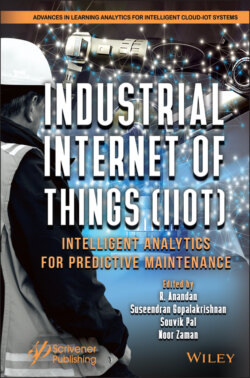Читать книгу Industrial Internet of Things (IIoT) - Группа авторов - Страница 14
1.2 Relationship Between Artificial Intelligence and IoT
ОглавлениеThe emergence of solutions and tools with AI (Artificial Intelligence) technology means solutions, tools, and software that have integrated resources that automate the process of making algorithmic decisions. The technology to be used can be anything from independent databases employing Machine Learning to pre-built models that can be employed to a diversity of data sets to solve paradigms related to image recognition and text analysis. Applied in the industry, it can help a business achieve a faster time to evaluate, reduce costs, increase productivity, and improve the relationship with stakeholders and customers [15, 16].
Machine Learning is only part of AI, that is, it is an AI application in which it accesses a large volume of data and learns from it automatically, without human intervention. This is what happens in the case of recommendations on video streaming platforms and facial recognition in photos on social media pages. AI is a broader concept that, in addition to Machine Learning, includes technologies such as natural language processing, neural networks, inference algorithms, and deep learning, in order to achieve reasoning and performance similar to that of human beings [15, 16].
An AI system is not only sufficient and capable of storing, analyze, and manipulating data, but also of acquiring, representing, and manipulating information and knowledge. Including the characteristic to infer or even deduce new knowledge, new relationships between data-generating information about facts and concepts, from existing information and knowledge and to use methods and procedures of representation, statistical analysis, and manipulation to solve complex questions that are often incognito and non-quantitative in nature [17].
The increase in mass data collection over the years, related to IoT devices, has boosted AI, given that the volume of information produced by people has been growing exponentially. But allied with Big Data technology to understand this massive set of data, which serves as a basis for learning the most diverse software, such as Machine Learning. This data revolution favored the AI scenario, i.e., with more information available, more intelligent, and automated ways to process, analyze, and use the data [18, 19].
Big data is the term employed to refer to the enormous amount of data that is produced and stored daily, evaluating that from this abundance of information, there are intelligent systems created to organize, analyze, and interpret (that is, process) the data, which are generated by multiple sources [19, 20], still pondering on predictive analysis as the ability to identify the probability of future results based on data, statistical algorithms, and machine learning techniques. From Big Data, it is possible to do this type of analysis, identifying trends, predicting behaviors, and helping to better understand current and future needs and, finally, to qualify decision-making in machines, equipment, and software, taking technology to a new level. AI is impacting society with machine learning systems, neural networks, voice recognition, predictive analysis, and natural language processing (NLP) and continuously remodeling new aspects of human life [19, 20].
Forecasting and adaptation are possible through algorithms that discover programmed data patterns, the solutions learn and apply their knowledge for future predictions. If a sequence of bits exists, then the AI recognizes the sequence and predicts its continuity. This is also able to correct spelling errors or predict what a user will type or even estimate time and traffic on certain routes in transit (autonomous vehicles based on AI) [17].
Decision-making through data analysis, learning, and obtaining new insights is able to predict or conjecture a more detailed and faster decision than a human being. But it helps to increase human intelligence and people’s productivity. Through continuous learning, AI can be considered a machine capable of learning from standards [21].
Also related to its characteristics in the ability to build analytical models from algorithms, learning to perform tasks through countless rounds of trial and error. In the same sense, NLP provides machines and computing devices the capability to “read” and even “understand” human language [22].
